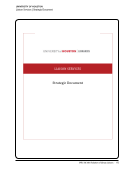54 · Survey Results: Survey Questions and Responses
If yes, what methods do you use? Check all that apply. N=64
Encourage liaisons to attend department meetings 63 98%
Market liaison services 62 97%
Other method 50 78%
Please briefly describe the other method. N=49
Annual meeting with departmental faculty liaisons
Any method of engagement that is appropriate for the respective department.
Anything and everything we can think of. Evolving every day. Classes, mailings, events, press releases, cooperative
programming, on-site embedded activities, teaching and collaborative teaching, shared positions, affiliate faculty status
within a department, etc.
At HSL, liaisons choose methods for their schools and programs. Most provide regular/annual reports about their
services to key administrative contacts. HSL regularly publishes success stories on its news page and “I Love My HSL
blog”, in annual reports, and other venues. The director and liaison meet annually, jointly, with health affairs deans,
hospital administrators, CTSA Program Director, and others with whom we have liaison personnel assigned.
Attend campus events.
Attend new faculty orientation, attend dissertation defenses and other departmental events, provide departmental
orientations, attend subject-specific conferences (e.g., Modern Language Association)
Blogs, newsletters, office hours, research projects
Calling for faculty to deposit documents into the Institutional Repository consulting on data management plans
Co-authoring papers and presentations locating grant opportunities consultation on content mining, data visualization,
and use of Libraries’ visualization spaces and displays assistance with finding and acquiring spatial and numeric data
consultation on using GIS and online mapping software participation in classes (sometimes) as a mock “client” for
student projects serving as final reviewers for student projects consultation on biosketches and other components of
grant proposals support for information management and citation management. Librarians attend seminars with clients
to build relationships and extend availability for informal questions.
Collaborative teaching and learning experiences. Collaborative projects such as teaching classes in the library with a
librarian actively participating in the class instruction.
Constant outreach on behalf of the liaison
Embedded librarians, library publications, formal and informal meeting opportunities with prospects
Embedding liaisons in places such as the Writing Center, attending talks and presentations in departments, partnering
with divisional deans on outreach, doing CV reviews for faculty to include items in our institutional repository, hiring
graduate students as interns to spread the word about library services and collections in their departments, support
faculty digital projects and digital humanities initiatives.
Encourage and promote liaison collaborations and outreach of all varieties, including department events, orientations,
embedded services, etc.
Engaging in research data management activities across campus will be one way for us to promote library services to
students and researchers.
If yes, what methods do you use? Check all that apply. N=64
Encourage liaisons to attend department meetings 63 98%
Market liaison services 62 97%
Other method 50 78%
Please briefly describe the other method. N=49
Annual meeting with departmental faculty liaisons
Any method of engagement that is appropriate for the respective department.
Anything and everything we can think of. Evolving every day. Classes, mailings, events, press releases, cooperative
programming, on-site embedded activities, teaching and collaborative teaching, shared positions, affiliate faculty status
within a department, etc.
At HSL, liaisons choose methods for their schools and programs. Most provide regular/annual reports about their
services to key administrative contacts. HSL regularly publishes success stories on its news page and “I Love My HSL
blog”, in annual reports, and other venues. The director and liaison meet annually, jointly, with health affairs deans,
hospital administrators, CTSA Program Director, and others with whom we have liaison personnel assigned.
Attend campus events.
Attend new faculty orientation, attend dissertation defenses and other departmental events, provide departmental
orientations, attend subject-specific conferences (e.g., Modern Language Association)
Blogs, newsletters, office hours, research projects
Calling for faculty to deposit documents into the Institutional Repository consulting on data management plans
Co-authoring papers and presentations locating grant opportunities consultation on content mining, data visualization,
and use of Libraries’ visualization spaces and displays assistance with finding and acquiring spatial and numeric data
consultation on using GIS and online mapping software participation in classes (sometimes) as a mock “client” for
student projects serving as final reviewers for student projects consultation on biosketches and other components of
grant proposals support for information management and citation management. Librarians attend seminars with clients
to build relationships and extend availability for informal questions.
Collaborative teaching and learning experiences. Collaborative projects such as teaching classes in the library with a
librarian actively participating in the class instruction.
Constant outreach on behalf of the liaison
Embedded librarians, library publications, formal and informal meeting opportunities with prospects
Embedding liaisons in places such as the Writing Center, attending talks and presentations in departments, partnering
with divisional deans on outreach, doing CV reviews for faculty to include items in our institutional repository, hiring
graduate students as interns to spread the word about library services and collections in their departments, support
faculty digital projects and digital humanities initiatives.
Encourage and promote liaison collaborations and outreach of all varieties, including department events, orientations,
embedded services, etc.
Engaging in research data management activities across campus will be one way for us to promote library services to
students and researchers.












































































































































































































